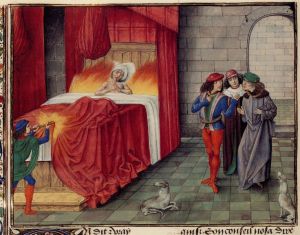Arts & Sciences Research Paper #17: You Won’t Believe How They Went!
Our seventeenth A&S Research Paper takes a turn to the lighthearted, and comes to us from Mistress Aildreda de Tamworthe of the Barony of Carolingia. She offers a tabloids-eye view of some of the more ghastly deaths of the medieval period – not necessarily to be considered for our lunchtime readers! (Prospective future contributors, please check out our original Call for Papers.)
You Won’t Believe How They Went! Five Strange and Terrible Medieval Ends

Nothing in his life / Became him like the leaving it.
– Wm. Shakespeare, Macbeth (1605), I.iv.
A person can achieve historical notoriety in many ways; brave deeds, terrible deeds, happy or cruel accidents of birth and geography, or even a greatly distinctive appearance. But one certain way to be remembered for posterity is to die in some memorable fashion. Today, the East Kingdom Gazette brings you five tabloid stories from history, wherein we learn of some of the more notorious exits of the Middle Ages. Please note that some are quite gruesome!
(NB: Like all good stories, these have been embroidered in the telling and the recollection. We have endeavored to provide the true tale in every case.)
Contents
Sigurd Eyesteinsson – Karma Bites Back
Martin of Aragon – No Laughing Matter
The Bal des Ardents – Practice Safe Cosplay!
Hugh Despenser – There’s No Outsmarting A Wolf
Charles of Navarre – The Cure Is Worse Than The Disease
Sigurd Eyesteinsson – Karma Bites Back
Sigurd (? – 892) was the Earl of Orkney in the latter half of the ninth century. Known as Sigurd the Mighty, he was a fearsome figure in the conquest of those northern Scottish isles by the Norwegian Harold Fair-hair. During one of the episodes of that invasion, Sigurd challenged a local chieftain, Maelbrigd the Buck-Toothed, to a battle with forty men on a side. Thinking to be crafty, Sigurd instead brought eighty men to the fight, winning it handily through superior numbers.
But in a strange twist of justice, Maelbrigd got his revenge. Sigurd struck off his foe’s head as a trophy and tied it to his horse’s saddle, thinking to display it as a mark of his prowess. As he rode, though, the head swung forward and the prominent teeth that gave Maelbrigd his nickname gouged a scratch in Sigurd’s leg. And as any playground veteran knows, the human mouth is a most unsanitary place – the scratch festered and quite soon Sigurd developed a gangrenous infection that killed him outright. Treachery does not pay!
Sigurd’s tale may be found in The Orkneyinger Saga.
Martin of Aragon – No Laughing Matter

King Martin of Aragon (c. 1356-1410), like so many of his contemporaries, had a court fool to entertain him when he was disconsolate. One evening, after eating an entire goose at the dinner table, King Martin was suffering from indigestion and called for his fool, one Borra, to ease his distress. When the fool entered the room, the King asked him where he had come from, and the fool said “Out of the next vineyard, where I saw a young deer hanging by his tail from a tree, as if someone had so punished him for stealing figs.”
Succumbing to this wordplay, whose subtle humor has no doubt been muddied through time and translation, King Martin is said to have laughed so heartily and so long that he indeed died of laughter. The question of whether or not this is a tale drafted by the cook to divert attention from the goose is left to the interested reader.
King Martin’s tale may be found in Dr. Doran’s The History of Court Fools, 317-318.
Back to Top
The Bal des Ardents – Practice Safe Cosplay!

In 1393, a masquerade ball was held in Paris by Isabeau, queen to Charles VI. As a bit of fun, the young King and several of his friends decided to dress as wild men, costuming themselves in linen soaked in resin that was stitched all over with loose flax, so that they would appear fierce and hairy. In a crowded ballroom where the only source of light was from flame, what could possibly go amiss?
The young men disported themselves crudely, making obscene gestures and howling and spitting curses at the assembled nobility. (It may be noted that the entire affair was instigated by one Huguet de Guisay, a cruel and arrogant young man who, among other things, used to hunt peasants with arrows from his castle walls.) They thought themselves safe because they had forbidden anyone carrying a torch to enter the hall while they were at sport. But the king’s brother, Louis d’Orléans, defied the ban and came close to a masked reveler, ostensibly to learn his identity.
Unsurprisingly, a stray spark fell onto the highly flammable costume and instantly the dancer was in flames. Rushing about, he set many of the other “wild men” on fire, as well as other guests; the King was saved only by his aunt, the young Duchess of Berry, who threw her skirts over him to protect him. The quick-thinking Ogier de Nantouillet jumped into a vat of wine until the flames were all extinguished, and also survived.
The other young men all perished from their awful burns, most of them slowly and painfully. The odious de Guisay lingered the longest, cursing the dead and the living for three whole days before he died. There are no reports of his death being haunted by the spirits of arrow-filled serfs.
The story of the Wild Men may be found in Froissart’s Chronicles.
Hugh Despenser the Younger– There’s No Outsmarting A Wolf

It is almost always a perilous thing to be a royal favorite. It is an especially perilous thing to be the favorite of a weak king who already has many enemies. Hugh Despenser the Younger (c. 1286 – 1326) was much beloved of King Edward II of England, and in his position of royal chamberlain, soundly proved the old adages about power going to the head – he even once reportedly said that he regretted that he could not control the wind! Indeed, Dispenser was so unpopular with everyone but the King that there was even a strange and curious plot wherein aggrieved courtiers enlisted the purported magician John of Nottingham to kill him (and the King) by sticking pins in their wax effigies.
We have no record of any discomfort from pins or effigies. But what we do know is that Edward’s Queen Isabella, nicknamed the “She-Wolf”, harbored a deep enmity toward Despenser, not least because he tried to have her murdered! When the Queen and her co-conspirator, Roger Mortimer, staged a very successful French-funded rebellion against the King, Despenser was captured and jailed. Knowing he was unlikely to escape with his life, Despenser tried to starve himself to death before his trial but was unsuccessful, coming quite alive to the trial and his almost immediate execution.
Here we learn that it can be exceptionally hazardous to try and fail to murder a wolf! Thanks to Jean Froissart’s love of a gory tale, we have a vivid account of Despenser’s death – he was bound to a ladder in the public square, where his genitals were cut off and burned before his eyes, his entrails slowly pulled out, and then his heart cut out and thrown into the fire. Once he was finally dead, his body was beheaded and quartered, and his severed head mounted on the gates of London. Who’s the apex predator now?
Hugh’s tale may be found in Froissart’s Chronicles.
Charles of Navarre – The Cure Is Worse Than The Disease

Charles II of Navarre, called the Bad (1332 – 1387) was an exceptionally slippery character in a century that is rife with examples of diplomatic shenanigans. Consummately committed to his own best interests, he maneuvered throughout the Hundred Years War, regularly switching sides, sowing chaos, and on one occasion even throwing open all the prisons in Paris to create a state of anarchy.
Late in life, Charles was severely debilitated by many illnesses and in such a state of decrepitude that he reportedly could not move his limbs. (Froissart claims that this was because of the “viciousness of his habits”.) His physician recommended that he be wrapped up from head to foot in linen cloths that had been thoroughly soaked in brandy. (Again, what could possibly go wrong?!) To ensure a tight and enveloping fit, the cloths were sewn into place by an attendant; but when she moved to remove the end of the thread with a candle, as was her usual habit, the thread caught fire and the entire covering was instantly in flames.
Another version of the story locates the source of the flame in a pan of hot coals that was being used to warm the invalid’s bed, but the end of the story is the same – Charles the Bad died in horrible agony from terrible burns, lingering almost an entire fortnight until he succumbed. Naturally, popular sentiment attributed the gruesome death to Divine judgment; how else would such a Bad king end?
Charles’s tale may be found in Froissart’s Chronicles.
We hope you have enjoyed this small diversion into some of the more lurid corners of history!
